Silver Valley trail bringing in gold

KELLOGG – Hundreds of cyclists pedal past Mike and Debbie Domby’s Kellogg bike shop each day. Most whiz by, intent on the mountain scenery that spans the 73-mile Trail of the Coeur d’Alenes. But a minority stop in, and it’s made all the difference to Excelsior Cycle.
Mike Domby tends to about five emergency bike repairs on a daily basis. Debbie Domby sells T-shirts, jackets and visors with Excelsior’s logo to out-of-town cyclists.
“We’re becoming a playground for people in Seattle and Portland,” Mike Domby said. “It helps us round out our tourism economy. It’s not just skiing anymore.”
The trail is a narrow ribbon of asphalt, stretching from Plummer to Mullan. It follows an abandoned railroad right of way. By paving the rail bed, regulators capped toxic metals that had spilled from train cars carrying ore from the Silver Valley. They also created a new economic engine.
As many as 100,000 people rode the trail during its first official year of operation in 2004, according to the Idaho Department of Parks and Recreation, which used laser counters to track use.
“The impact of the bike trail is second only to Silver Mountain and Lookout Pass Ski Area. It might even have more of an impact, because it’s so spread out,” said Joe Peak, owner of the Enaville Resort.
Peak estimates that 60 percent of his weekend restaurant receipts are trail-related during the summer months. The resort is located near one of the trail’s most popular trailheads, an entry point to a 14-mile, shaded ride along the Coeur d’Alene River. It’s not unusual to see 40 vehicles congregated at the trailhead, Peak said.
At the Super 8 Motel in Kellogg, the number of nights booked by cyclists is overtaking skier visits, said owner Ken Schueman. By midafternoon, the motel’s 61 rooms are often full. Employees end up referring customers to other lodging properties.
“I think the impact of a trail visitor is as good or better than a ski visitor,” Schueman said. “Trail visitors probably spend more time shopping.”
Cyclists, as a group, are an attractive demographic, said Jon Ruggles, president of a local group, Friends of the Coeur d’Alene Trails. Like skiers, cyclists tend to have higher income brackets.
Based on studies done on other rails-to-trails project, Ruggles estimated the trail’s impact at $6 million during its first year. Riders contribute an average of $5 to $10 to the local economy every time they use the trail through purchases of gas, food and lodging, Ruggles said. Even local riders have a positive benefit.
Ruggles’ group wants to increase cycling opportunities by connecting trails. They’re using a $22,000 state grant this summer to improve the Nor-Pac Trail, which connects the Trail of the Coeur d’Alenes to the Route of the Hiawatha. The 11-mile Nor-Pac Trail runs from Mullan to Lookout Pass.
The Trail of the Coeur d’Alenes’ popularity has spread with limited marketing, said Bill Scudder, the state’s trail manager.
Articles in rails-to-trails magazines have been a good source of free publicity, he said. Cyclists also do their part by telling their friends. Scudder’s staff responds to about 50 requests for trail information each week. The inquiries “cover the entire U.S.,” he said.
Last week, Gary Chambers waited at Excelsior Cycle while the gears on his son’s bike were repaired. Chambers was part of a group of 17 Scouts and Scout leaders from Portland on a three-day cycling trip. The Scouts kept track of the wildlife they spotted along the trail. The tally included moose, golden eagles and ospreys.
“Usually, we plan a trip in the San Juan Islands, but the traffic’s atrocious and there’s no dedicated bike lanes,” Chamber said. “We love this. … I have a feeling that we’ll be back next year with a bigger group.”
At the KOA campground in Pinehurst, where the Scouts stayed, about 20 percent of the summer clientele are cyclists. They often ride both the Trail of the Coeur d’Alenes and the Route of the Hiawatha, another rails-to-trails project, said Kathy Edlund, co-owner of the KOA. Mountain biking trails on Silver Mountain are also a destination.
“The feedback we’ve gotten is that this is world-class trail,” Edlund said. A surprising number are older riders – fit folks in their 70s and 80s. One couple, former Olympic speed skaters, were in their early 90s, Edlund said. They cycled the entire length of the trail one day, and skated it the next.
The Dombys of Excelsior Cycle said they’re seeing a resurgence of local interest in biking, as well. Seniors who gave up cycling years ago are back in the saddle.
“The trail’s convenient, safe, flat and beautiful,” Debbie Domby said.
Sales of recumbent bikes and comfort bikes are climbing. But so are sales of road bikes, tandems, and full-blown mountain bikes. Room for inventory is getting tight in the 1,400-square-foot shop, a former rail freight depot.
“Not any one of these segments is going up,” Mike Domby said. “They’re all going up.”